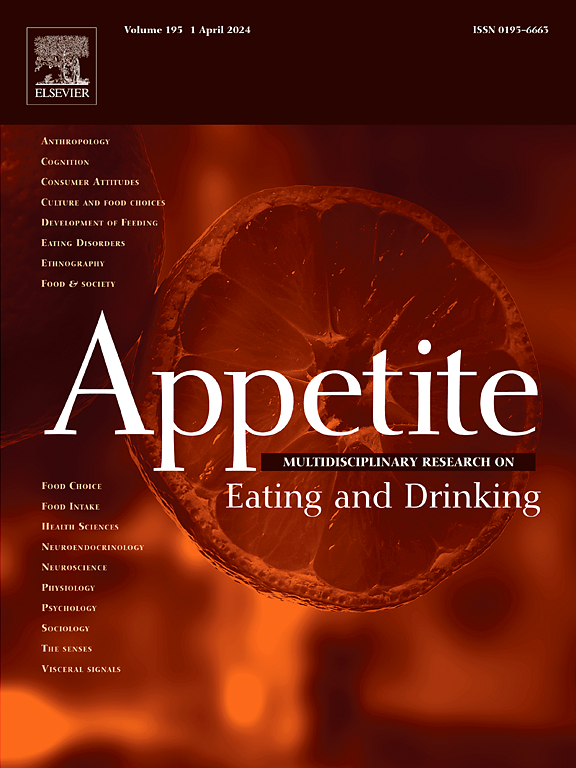儿童对他人如何分享食物偏好和健康相关信息的期望
IF 3.8
2区 医学
Q1 BEHAVIORAL SCIENCES
引用次数: 0
摘要
幼儿在与食物相关的学习中表现出消极偏见,对消极信息表现出高度的关注和记忆。如果孩子们不仅更多地关注负面信息,而且还将其广泛地推广到人们身上,帮助他们避免潜在的有害食物,那么这种偏见可能会特别具有适应性。然而,关于儿童如何根据信息的效价(积极与消极)和类型(偏好与健康影响)来概括他人积极和消极的食物相关信息,我们知之甚少。研究人员进行了两项实验,以调查年幼的日本儿童如何期望他人分享与食物有关的积极和消极信息。在实验1中,3-5岁儿童(N = 33, M = 51.33个月,SD = 5.64个月)对不喜欢的食物比喜欢的食物更希望与人分享。在实验2中,4-6岁儿童(N = 34, M = 71.68个月,SD = 5.17个月)期望食物的负面健康效应比正面健康效应更能被人分享。这些结果表明,儿童对与食物有关的负面信息——厌恶和对健康的负面影响——的概括比正面信息更广泛。将他人对食物的负面反应视为广泛适用的,可能是一种保护策略,帮助儿童在早期的食物环境中避免潜在的饮食危险。这项研究可能会告诉护理人员和教育工作者如何以符合儿童认知偏见的方式传达健康信息,最终支持健康饮食习惯的养成。本文章由计算机程序翻译,如有差异,请以英文原文为准。
Children's expectations about how others share food preferences and health-related information
Young children exhibit a negativity bias in food-related learning, showing heightened attention to and memory for negative information. This bias may be especially adaptive if children not only attend more to negative information but also generalize it broadly across people, helping them avoid potentially harmful foods. However, little is known about how children generalize others' positive and negative food-related information, depending on the valence (positive vs. negative) and type (preferences vs. health effects) of the information. Two experiments were conducted to investigate how young Japanese children expect others' positive and negative food-related information to be shared among people. In Experiment 1, children aged 3–5 years (N = 33, M = 51.33 months, SD = 5.64 months) expected food dislikes to be shared among people more than food preferences were. In Experiment 2, children aged 4–6 years (N = 34, M = 71.68 months, SD = 5.17 months) expected negative health effects of food to be shared among people more than positive health effects. These results suggest that children generalize negative food-related information—both aversions and negative health effects—more broadly than positive information. Viewing others' negative reactions to food as widely applicable may serve as a protective strategy, helping children avoid potential dietary dangers as they navigate their early food environments. This study may inform caregivers and educators about how to communicate health messages in ways that align with children's cognitive bias, ultimately supporting the development of healthy eating habits.
求助全文
通过发布文献求助,成功后即可免费获取论文全文。
去求助
来源期刊

Appetite
医学-行为科学
CiteScore
9.10
自引率
11.10%
发文量
566
审稿时长
13.4 weeks
期刊介绍:
Appetite is an international research journal specializing in cultural, social, psychological, sensory and physiological influences on the selection and intake of foods and drinks. It covers normal and disordered eating and drinking and welcomes studies of both human and non-human animal behaviour toward food. Appetite publishes research reports, reviews and commentaries. Thematic special issues appear regularly. From time to time the journal carries abstracts from professional meetings. Submissions to Appetite are expected to be based primarily on observations directly related to the selection and intake of foods and drinks; papers that are primarily focused on topics such as nutrition or obesity will not be considered unless they specifically make a novel scientific contribution to the understanding of appetite in line with the journal's aims and scope.
 求助内容:
求助内容: 应助结果提醒方式:
应助结果提醒方式:


